U.S. Department of Transportation
Federal Highway Administration
1200 New Jersey Avenue, SE
Washington, DC 20590
202-366-4000
Fall summits gave transportation professionals across the country a forum to learn about the innovations in the fourth round of Every Day Counts (EDC-4), the Federal Highway Administration’s partnership with stakeholders to rapidly deploy innovations.
The summits—held in California, Florida, Maryland, Minnesota, New York, Oregon, and Texas—introduced participants to the 11 technologies and practices FHWA will promote in 2017 and 2018 through EDC-4. Interactive working sessions provided an indepth look at the innovations, how the transportation community is using them, and assistance available to help more States deploy them.
Participants met in State caucuses to start planning which EDC-4 innovations to pursue over the next two years. Their recommendations will be discussed by State Transportation Innovation Councils (STICs), which bring together public and private stakeholders in each State to evaluate innovations and spearhead deployment.
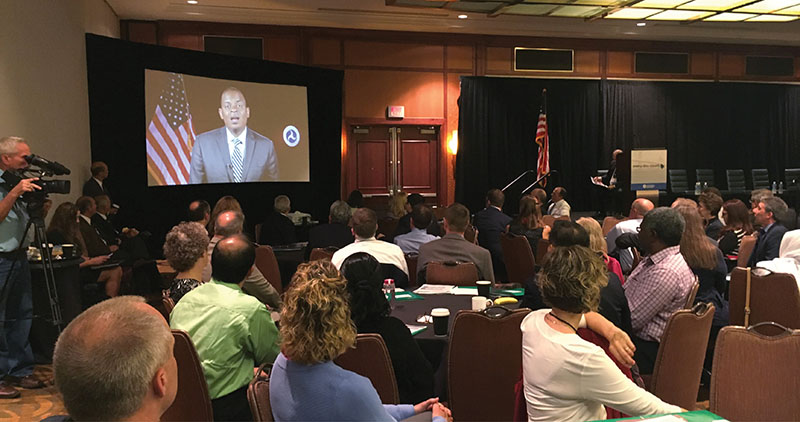
U.S. Transportation Secretary Anthony Foxx spoke to Baltimore summit participants via video.
“You serve enthusiastically on the front lines of innovation deployment and make a measureable difference in each of your States,” he said. “And you continue to earn the trust of the American people to improve their safety, support their economy, and meet their demand for the most cost-effective use of every dollar they invest in transportation.”
Nadeau cited three key developments in the transportation community’s pursuit of innovation:
The Federal Highway Administration is promoting 11 innovations in Every Day Counts round four (EDC-4):
Automated traffic signal performance measures modernize traffic signal management by providing high-resolution data to actively manage performance and improve safety and customer service while cutting congestion and costs.
The effort on collaborative hydraulics: advancing to the next generation of engineering (CHANGE) uses hydraulic tools to improve understanding of complex interactions between river or coastal environments and transportation assets, enabling better design and more efficient project delivery.
Community connections are performance management approaches for planning, designing, and building transportation projects that promote connectivity, revitalize communities, and improve public health and safety.
Data-driven safety analysis uses tools to analyze crash and roadway data to predict the safety impacts of highway projects, enabling agencies to target investments with more confidence and reduce severe crashes on roads.
e-Construction and partnering: a vision for the future involves using paperless technologies to enhance partnering among stakeholders on construction projects, improving communication and workflows while streamlining project delivery.
Integrating the National Environmental Policy Act and permitting processes enables concurrent, synchronized environmental and permitting reviews that save time and reduce costs for the agencies involved.
Pavement preservation (when, where, and how) involves applying a pavement preservation treatment at the right time on the right project with quality materials and construction, offering a critical investment strategy for optimizing infrastructure performance.
Road weather management—weather-savvy roads integrates mobile observations and Pathfinder strategies in collaboration with the National Weather Service that can help agencies manage road systems and inform travelers ahead of and during adverse road weather conditions.
Safe transportation for every pedestrian (STEP) features cost-effective countermeasures with known safety benefits that can reduce pedestrian fatalities at uncontrolled crossing locations and unsignalized intersections.
Ultra-high performance concrete can be used to create the simple, strong, long-lasting connections needed for successful construction using prefabricated bridge elements.
Using data to improve traffic incident management focuses on increasing the amount, consistency, and quality of data collection to support development of performance measures for evaluating and improving traffic incident response programs.
View introductory webinars on the EDC-4 innovations.
With Every Day Counts round four (EDC-4) underway, agencies across the Nation are deciding which proven innovations they will incorporate as standard practice in the next two years. But transportation leaders have a larger question on their minds: How do we make the adoption of innovation part of our everyday work, ingrained in our culture?
At the EDC-4 summit in Baltimore, MD, leaders from seven States and Federal Lands Highway took part in a panel discussion to examine that question and share ways they’re building a culture of innovation in their organizations.
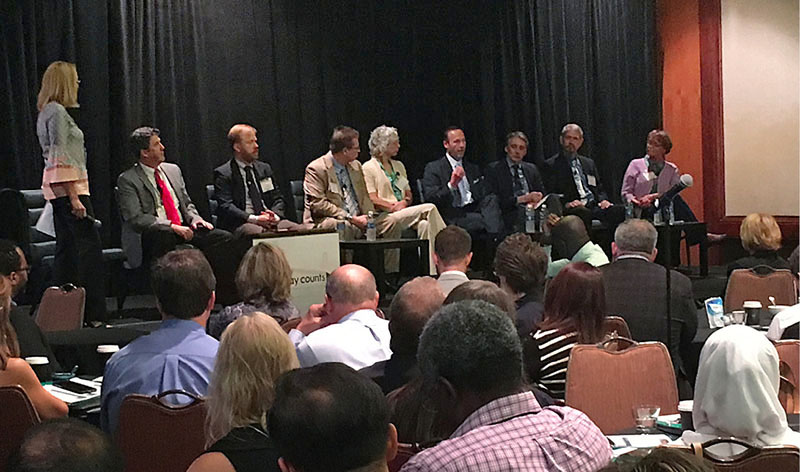
At the Baltimore summit, transportation leaders exchanged ideas on building a culture of innovation in their States.
“You must create a forum where people can have those discussions and have a willingness to listen,” said Rob McCleary, chief engineer of the Delaware Department of Transportation. “You have to actually ask the questions, to get engaged.”
“The key to all of this is communication—up and down the chain of command, leadership to industry,” said Todd Rumbaugh, deputy State highway engineer for the West Virginia Department of Transportation. “If that’s not there, it falls apart pretty quickly.”
“Overcoming the tendency toward specialization inherent in engineering is crucial,” McCleary said. “Bringing interdisciplinary groups together makes innovation much more widespread.”
“You also have to be very strategic in how you roll out an innovation,” Kuhn said. “You want to try those innovations someplace where you’re able to fail and learn from that failure.”
“You can’t just let the industry drive it,” Rumbaugh said. “For example, industry wanted a firm commitment that our DOT was moving toward warm-mix asphalt before they were on board. I’m happy to say that next year we will be 100 percent warm-mix.”
“Give the idea a beta period—small steps to see how the technology works rather than going all in,” said Melissa Batula, chief of the Pennsylvania Department of Transportation’s Highway Delivery Division. “Choose examples where you can invest a discreet amount of time, effort, and money.”
“If you’re clear on the parameters, engineers are really good at problem-solving,” said Jason Siwula, assistant State highway engineer for the Kentucky Transportation Cabinet. “We have to plan things we can actually build. We have to build things we can actually maintain. It’s really about getting the whole group to the table and brainstorming.”
All participants agreed that the question was not if, but how agencies should become more innovative.
“Our customer expectations are completely changed,” Kuhn said. “The expectation today is that we cannot solve tomorrow’s transportation issues with yesterday’s solutions.”
“Together, these milestones will ensure that the cycle we’re engaged in today of identifying, considering, and deploying innovation will become an ongoing part of our industry,” Nadeau said.
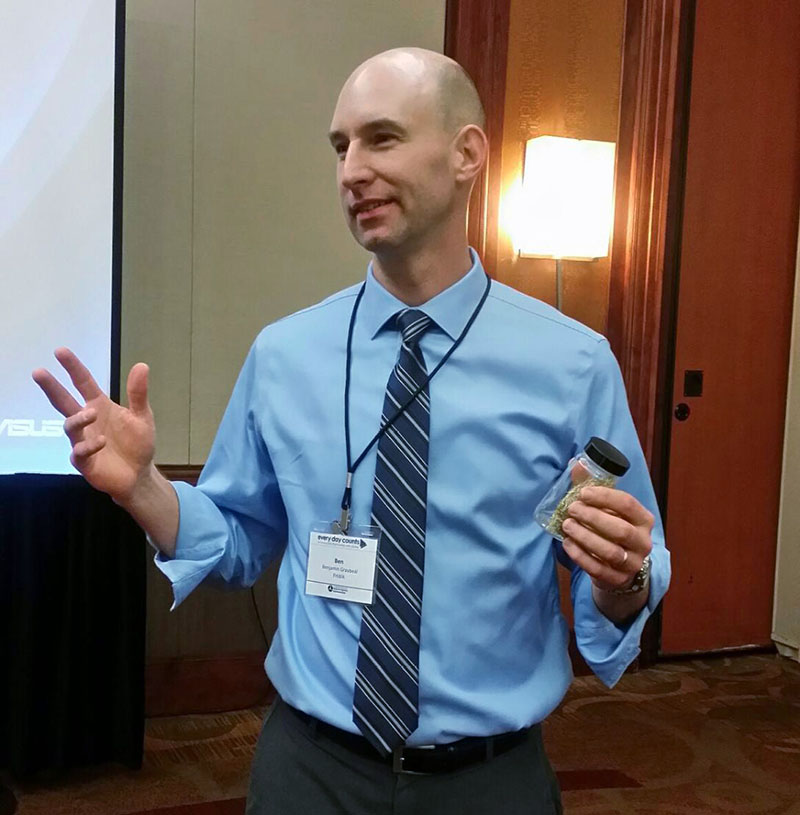
In an EDC-4 innovation session, Benjamin Graybeal of FHWA discussed the benefits of using ultra-high performance concrete connections to build long-lasting bridges.
Attending the EDC summits every other year offers District Department of Transportation staff members an opportunity to learn about new ideas that can improve how they deliver transportation programs to the public, said Director Leif Dormsjo.
“Every time we participate, it gives our team new energy and perspectives on problems that other groups have looked at solving,” he said. “It really does accelerate how we get things done.”
The EDC initiative encourages State transportation departments “to be innovative, to take risks, to find new and better ways to do things. That’s why it’s important for DOTs as well as for taxpayers,” said Maryland Transportation Secretary Pete Rahn.
“We are very interested in delivering practical transportation solutions for the traveling public,” Rahn said. “What that means for us is how do we do it better, faster, and cheaper so that we can save money, do a good job, and do more for our citizens.”
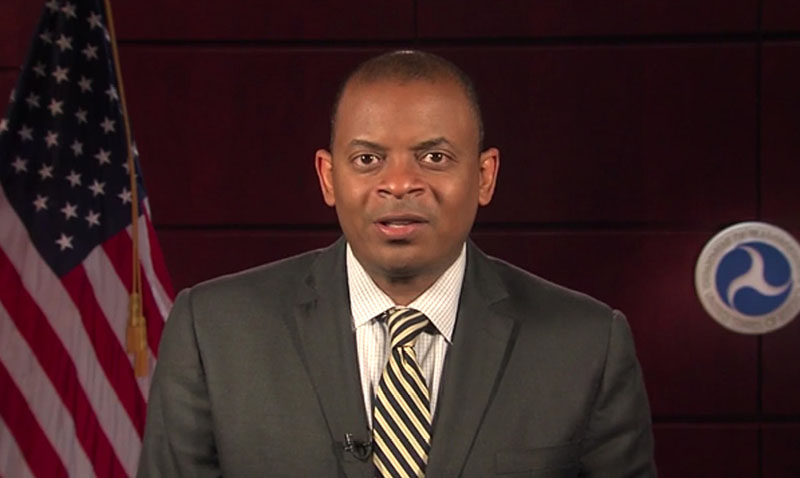
U.S. Transportation Secretary Anthony Foxx welcomed participants to the EDC-4 summits via a video presentation.
Thomas Harman, director of the FHWA Center for Accelerating Innovation, which administers the EDC initiative, issued what he called a “two percent challenge” to summit participants.
“Two percent of a day is only half an hour,” he said. “If you can spend just two percent of a day once a week focusing on innovative ideas, you can help advance the culture of innovation in your agency.”
FHWA formed deployment teams for each EDC-4 innovation to help States and their partners with implementation efforts. Using feedback obtained during the summits, the teams developed plans to provide the transportation community with technical assistance and training, including workshops and peer exchanges.
FHWA also offers assistance and funds through the STIC Incentive and Accelerated Innovation Deployment (AID) Demonstration programs. The STIC Incentive program provides up to $100,000 a year per State to help STICs make innovations standard practice. The AID Demonstration program awards funding of up to $1 million for highway projects that use proven innovations in any project phase.
An ideal traffic incident management (TIM) program relies on efficient data collection, analysis, and reporting to measure performance and identify where and when it can be improved.
“If it gets measured, it gets performed,” said Paul Jodoin, manager of the Federal Highway Administration’s TIM program and a leader of the Every Day Counts (EDC) team on using data to improve TIM.
In the EDC fourth round (EDC-4), FHWA is encouraging the use of available technology to increase the dataset associated with three standard TIM performance measures:
TIM-related data can be collected with existing advanced transportation management systems, computer-aided dispatch software, electronic crash reporting systems, and smart devices. A few agencies already collect data with each of these systems.
Arizona, for example, easily modified its Traffic and Criminal Software—or TraCS—system at a low cost to collect data for the three TIM performance measures. Tennessee uses a locally developed electronic crash reporting system that collects data for two of the key performance measures.

Improving data collection offers several benefits:

As traffic incident management activities increase, so does the need to capture data that can be used to assess program performance and drive improvements.
Jodoin identified several challenges involved in improving data management:
The Michigan Department of Transportation produces a monthly TIM performance report for the Southeast Michigan Traffic Operations Center and the agency’s western region. Michigan creates a number of graphs that show average roadway clearance times and incident clearance details. “That’s a perfect example of where we’d like to go as a Nation,” said Jodoin.
Another example comes from the Virginia Department of Transportation, which produces monthly and quarterly TIM performance reports. Graphs show trends in average incident clearance times and other data.
During the EDC-4 cycle in 2017 and 2018, FHWA will track the number of States that collect data on all three TIM performance measures, collect and use data, and add at least one performance measurement to electronic crash reports.
“We would like to increase the number of States and locations that progress to the next level of data management,” said Jodoin. “Typically agencies move through a development phase, where they are thinking about how to move forward, a demonstration phase, an assessment phase, and finally they institutionalize the innovation.”
The EDC-4 effort allows FHWA to work with and support agencies interested in moving to the next level, Jodoin said. That next level would continue to enhance safety and efficient mitigation of roadway incidents.
View an EDC-4 Webinar on using data to improve TIM.
See the National Cooperative Highway Research Program’s Guidance for Implementation of TIM Performance Measurement Web page for an overview and model database.
Visit FHWA’s TIM Knowledgebase for tools and resources on practices and performance measurement.
Contact Paul Jodoin or Kimberly Vasconez of the FHWA Office of Operations for information and technical assistance.
Leadership support and grassroots involvement have contributed to the success of the Massachusetts State Transportation Innovation Council (STIC).
“From the beginning we’ve had really good management support from the transportation secretary on down,” Patricia Leavenworth, Massachusetts Department of Transportation (MassDOT) chief engineer, told transportation leaders during a national STIC Web conference on October 12, 2016. “And we have good representation from industry and State and local agencies.”
Originating from Volpe National Transportation Systems Center in Cambridge, MA, the Webcast featured public agency and private sector members of the Massachusetts STIC discussing how the council is creating an innovative culture in the State.
After forming in 2011, the Massachusetts STIC pursued implementation of 27 Every Day Counts (EDC) innovations during the first three rounds of the Federal Highway Administration initiative. For each innovation, the STIC assembles a deployment team that develops an implementation plan and reports on progress at quarterly STIC meetings.
MassDOT also created a READi Committee—named for its mission to review, evaluate, accelerate, and deploy innovation—to provide a central point for integrating new technologies, practices, and products throughout the agency.
“We wanted to bring a team together to look at technologies and figure out how we can take advantage of them,” Leavenworth said. “We also wanted to make sure we communicate the progress we’re making, the lessons we’re learning, and the technologies we’re using.”
Massachusetts STIC successes include projects built with the design-build contracting method and deployment of innovations such as e-Construction technologies, smarter work zones, and ultra-high performance concrete connections for prefabricated bridge components.
“Necessity is the mother of innovation,” said Thomas Tinlin, MassDOT highway administrator and Massachusetts STIC cochair, in his adaptation of an old saying. “As we look at new ways of doing things, it’s really out of necessity. We can’t be so afraid to take risk that we’re not willing to be innovative.”
When it comes to innovation, “success builds on success,” said Dennis Baker of the American Council of Engineering Companies of Massachusetts. He cited the use of accelerated bridge construction on the MassDOT FAST 14 project to rapidly replace bridges during a series of short-term closures in 2011.
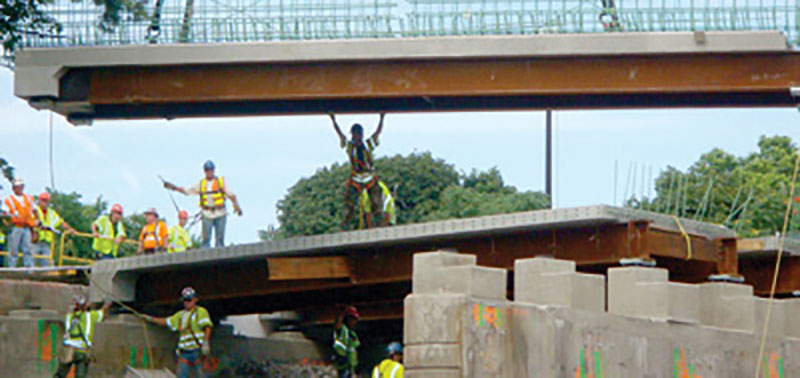
Crews used accelerated bridge construction techniques to quickly replace 14 bridges in a Massachusetts project.
“Most communities at that time were highly reluctant to accept any complete closure of a facility,” he recalled. “Once they saw the success of FAST 14 and other accelerated bridge projects, communities have been coming forward and asking for more.”
Richard Benevento of the New England Chapter of the American Public Works Association discussed the benefits to local agencies of innovation deployment.
“It’s important for any public agency, particularly cities and towns, to be able to tap into the innovations coming out of EDC and be at the STIC table to talk about how to do more with less,” he said.
STICs are essential to making EDC a State-based initiative and the national STIC network “is the single most important factor in creating a permanent culture of innovation in the transportation sector,” said Federal Highway Administrator Gregory Nadeau.
“Each STIC represents its own unique version of the partnership among Federal, State, and local governments; the private sector; and the academic community,” Nadeau said. “That partnership is at the heart of EDC.”
Innovation has been part of the FHWA culture since the Agency’s early days in the late 1800s, and it will continue to be a priority, FHWA Executive Director Butch Waidelich told Webcast participants.
“Each STIC and the national STIC network play an important role in advancing innovation,” Waidelich said. “You are the front line. Together, we identify challenges and work to identify and implement innovation at the Federal, State, tribal, and local levels.”
Dr. Chris Gerdes, U.S. Department of Transportation chief innovation officer, guided STIC Webcast participants through an exercise to expand discussions on innovations.
“Innovation is applying creativity to develop ideas that are new to the world,” Gerdes told participants. “This is increasingly important in transportation. Ideas that worked 20 years ago are maybe not working today and certainly won’t work 20 years in the future.”
Gerdes outlined three ways to generate innovative ideas:
“If you never ask ‘what if?’ you never get there,” he said. “Step out in the future a certain number of years and try to think what life would be like. If you have a problem to solve, assume you’ve solved it and start to work backwards.”
“This comes from an exercise in improvisation. The idea is to accept what somebody is saying and add on top of that. You end up with something unique that builds on both people’s ideas. An easy way to practice this is to have a conversation where every sentence begins with ‘yes, and.’”
One way to succeed at something that’s never been done before is by breaking it into a series of steps. “Small steps allow team members to try out prototypes and build relationships with stakeholders. So taking the next step is important with innovation. It takes ideas out of your head and keeps them moving.”
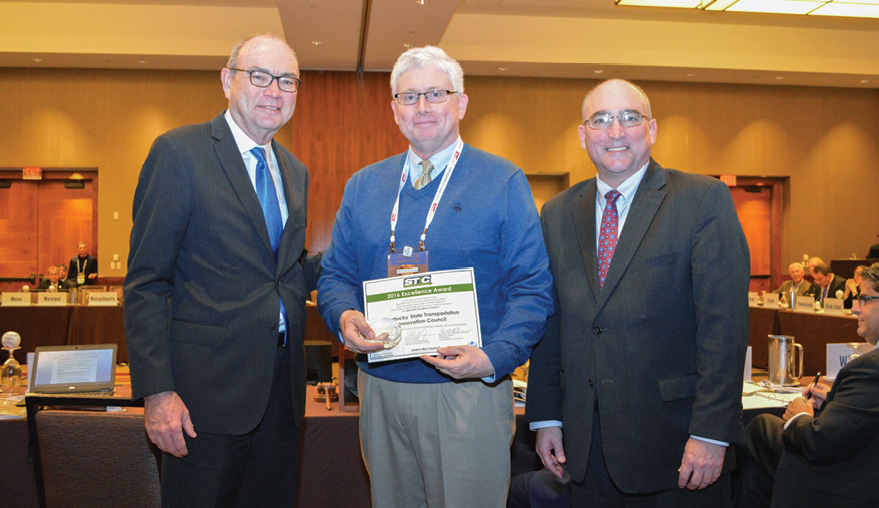
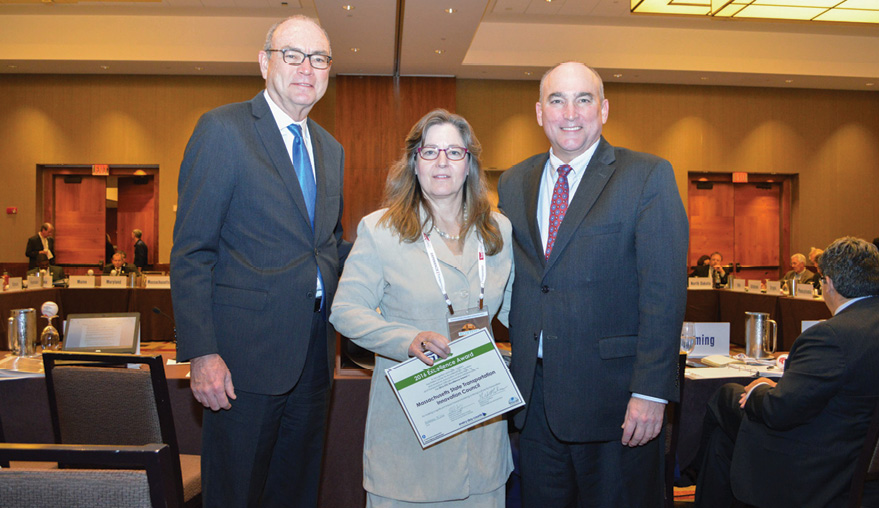
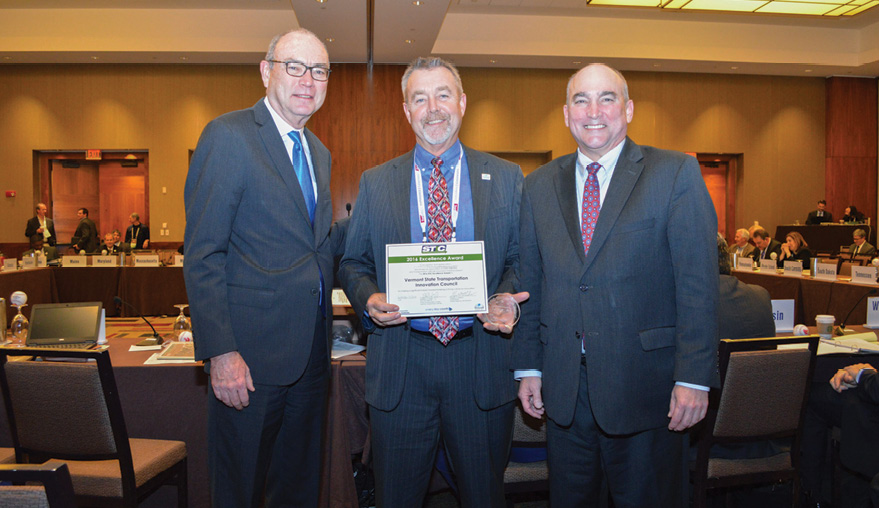
(Photos top to bottom) Kentucky Transportation Cabinet Secretary Greg Thomas, Massachusetts Department of Transportation Chief Engineer Patricia Leavenworth and Vermont Agency of Transportation Secretary Chris Cole (center in photos) received the first STIC Excellence Awards from AASHTO Executive Director Bud Wright (left) and Federal Highway Administrator Gregory Nadeau (right). Credit: American Association of State Highway and Transportation Officials
This inaugural award reflects the partnership between AASHTO and FHWA to promote innovation nationwide. During the AASHTO Board of Directors meeting, AASHTO Executive Director Bud Wright and Federal Highway Administrator Gregory Nadeau offered highlights of the award recipients’ accomplishments.
“The Kentucky STIC incorporates crosscutting technology evaluation and implementation of Every Day Counts, the second Strategic Highway Research Program, and traditional research innovations,” Wright said.
The Kentucky Transportation Cabinet created a senior management position to lead integration and standardization of innovative processes throughout the State. Use of high-friction surface treatments and the Safety Edge™ paving technique contributed to an 85 percent drop in roadway crashes. An accelerated bridge construction policy encourages continuous innovation on bridge projects.
“The multistakeholder leadership of the Massachusetts STIC perpetuates the deployment of innovation throughout the State,” said Nadeau.
The Massachusetts STIC influenced the Massachusetts Department of Transportation (MassDOT) to form a READi Committee—for review, evaluate, accelerate, and deploy innovation—to review and recommend innovations for deployment. MassDOT holds an annual Innovation and Tech Transfer Exchange to share new ideas in transportation technology. It used accelerated bridge construction on its FAST 14 project to replace 14 bridges on I–93 over 10 weekends.
“The Vermont STIC Executive Council members meet monthly to discuss innovative ideas, advancements in technology, and how they can be used to meet today’s challenges,” said Wright.
The Vermont STIC holds an annual meeting to brainstorm innovative ideas with representatives of industry, municipalities, and planning organizations. The Vermont Agency of Transportation established a Performance, Innovation, and Excellence Section to lead innovation efforts. Vermont has institutionalized use of the design-build project delivery method and is considered a regional leader in the contracting technique.
Fall 2016 was a busy time of firsts and openings for transportation innovators across the country.
Thirteen innovators presented their ideas and shared lessons learned at the first Arizona Innovation Exchange Day in Phoenix. More than 150 transportation professionals attended the October 4, 2016, event organized by the Arizona Council for Transportation Innovation, part of the national State Transportation Innovation Council network. Keynote presentations covered effective decision making and the changing transportation environment.
A ceremony in Iowa celebrated the opening of the Catt Bridge in Buchanan County. The new bridge features a glued laminated timber—or glulam—superstructure supported on a geosynthetic reinforced soil abutment. The U.S. Forest Service and Iowa State University’s Institute for Transportation developed the innovative design and Buchanan County work crews built the bridge. The Federal Highway Administration provided technical assistance on design and construction.
The city of Concord, NH, held a ribbon-cutting ceremony to mark the completion of its Main Street reconstruction project. The project, which received a Transportation Investment Generating Economic Recovery, or TIGER, grant, was New Hampshire’s first to use the construction manager/general contractor delivery method. The project was designed to improve vehicle, bicycle, and pedestrian safety and transit accessibility.
New Mexico’s first diverging diamond interchange is open to traffic. The new interchange at I–25 and Cerrillos Road in Santa Fe was completed on time and on budget. The New Mexico Department of Transportation chose the diverging diamond design to improve safety and efficiency, reduce congestion, and accommodate future traffic needs. Visit the project Web site for a virtual tour of how to drive the interchange.
Accelerated bridge construction, including geosynthetic reinforced soil-integrated bridge system technology, enabled the Rhode Island Department of Transportation (RIDOT) to save motorists a year of traffic delays on projects to replace two bridges in East Providence. One bridge was replaced during an 83-hour road closure between September 9 and 13, 2016. The other bridge replacement was even faster, with the shutdown lasting 65 hours from September 23 to 26. RIDOT plans to use accelerated bridge construction on 75 bridge repair projects by 2025.

Officials celebrate an interchange opening on Wisconsin’s I-41 project.
The Wisconsin Department of Transportation held a ceremony in Green Bay to celebrate the substantial completion of the I–41 project and the opening of the I–41/I–43 system interchange to traffic. The project, one of Wisconsin’s largest highway construction projects, spans more than 30 miles in Brown and Winnebago Counties and includes reconstruction or improvement of 16 interchanges and 40 roundabouts. The project will be fully completed in June 2017.
Innovator, published by the FHWA Center for Accelerating Innovation, advances implementation of innovative technologies and accelerated project delivery methods in the highway industry. Its audience is transportation professionals in highway agencies, trade and research groups, academia and the private sector, and the driving public.
Anthony R. Foxx, Secretary, U.S. DOT
Gregory G. Nadeau, Administrator, FHWA
Thomas Harman, Director
Jeffrey Zaharewicz, Senior Advisor
Sara Lowry, Program Coordinator
Ewa Flom, Program Coordinator
Julie Zirlin, Program Manager
Nichole Causey, Marketing Specialist
Ellen Schweppe, Managing Editor
James Cline, Jr., Designer
Rodney Walker, Designer
Rebecca Taylor, Designer
Email reprint requests to: Julie.Zirlin@dot.gov